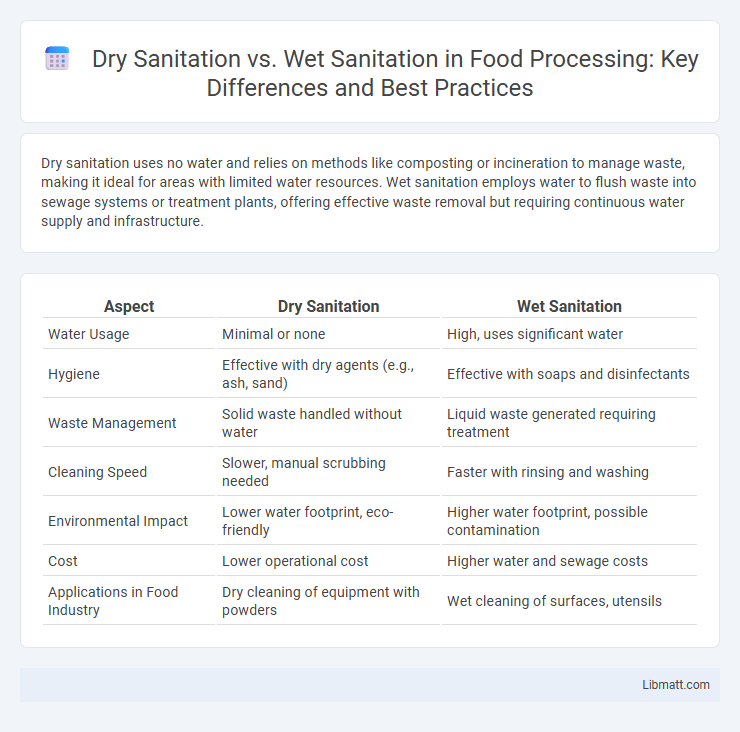Dry sanitation uses no water and relies on methods like composting or incineration to manage waste, making it ideal for areas with limited water resources. Wet sanitation employs water to flush waste into sewage systems or treatment plants, offering effective waste removal but requiring continuous water supply and infrastructure.
Table of Comparison
| Aspect | Dry Sanitation | Wet Sanitation |
|---|---|---|
| Water Usage | Minimal or none | High, uses significant water |
| Hygiene | Effective with dry agents (e.g., ash, sand) | Effective with soaps and disinfectants |
| Waste Management | Solid waste handled without water | Liquid waste generated requiring treatment |
| Cleaning Speed | Slower, manual scrubbing needed | Faster with rinsing and washing |
| Environmental Impact | Lower water footprint, eco-friendly | Higher water footprint, possible contamination |
| Cost | Lower operational cost | Higher water and sewage costs |
| Applications in Food Industry | Dry cleaning of equipment with powders | Wet cleaning of surfaces, utensils |
Understanding Dry Sanitation Systems
Dry sanitation systems use minimal or no water for waste treatment, relying instead on methods like composting, dehydration, or incineration to manage human waste. These systems reduce water consumption, lower contamination risks, and are ideal for areas with limited water supply or poor drainage. You can improve hygiene and sustainability by choosing dry sanitation solutions tailored to off-grid or resource-scarce environments.
Exploring Wet Sanitation Technologies
Wet sanitation technologies utilize water to flush waste through sewer systems, offering efficient removal and treatment of human excreta. Innovations in wet systems include vacuum toilets, dual-flush mechanisms, and advanced sewage treatment plants that reduce water consumption and enhance pathogen removal. These technologies support urban infrastructure by integrating with centralized wastewater treatment, ensuring public health and environmental protection.
Key Differences Between Dry and Wet Sanitation
Dry sanitation systems use no water, relying on methods like composting or urine diversion to manage waste, making them suitable for areas with limited water resources. Wet sanitation employs flushing toilets and sewage systems to transport waste through water, commonly found in urban settings with established infrastructure. Key differences include water use, infrastructure complexity, maintenance requirements, and environmental impact, with dry sanitation being more sustainable in water-scarce regions and wet sanitation providing higher hygiene standards where water supply and sewage treatment are accessible.
Environmental Impact of Sanitation Methods
Dry sanitation systems minimize water consumption and reduce wastewater generation, significantly lowering the risk of water pollution and conserving freshwater resources. Wet sanitation relies heavily on water, often leading to contamination of water bodies through untreated or inadequately treated sewage discharge. Implementing dry sanitation can contribute to sustainable waste management by promoting nutrient recycling and decreasing greenhouse gas emissions associated with conventional sewage treatment.
Water Consumption: Dry vs Wet Sanitation
Dry sanitation systems use little to no water, significantly reducing your household's water consumption compared to wet sanitation, which relies heavily on water for flushing. Wet sanitation facilities can consume up to 6 liters per flush, leading to higher water usage and increased utility bills. Choosing dry sanitation minimizes water waste and supports sustainable water management in areas facing water scarcity.
Cost Implications of Sanitation Choices
Dry sanitation systems typically involve lower installation and maintenance costs due to minimal water usage and simpler infrastructure requirements, making them cost-effective for water-scarce regions. Wet sanitation demands significant investment in water supply, sewage networks, and wastewater treatment, often increasing operational expenses and overall lifecycle costs. The choice between dry and wet sanitation significantly impacts long-term financial sustainability, especially in urban versus rural settings.
Health and Hygiene Considerations
Dry sanitation systems minimize water usage and reduce the risk of waterborne diseases by preventing contamination of groundwater and surface water. Wet sanitation relies on flushing and treatment in sewage systems, which, if improperly managed, can lead to the spread of pathogens and increased health risks. Your choice between dry and wet sanitation should consider local infrastructure, water availability, and potential impacts on community health and hygiene.
Applicability in Urban and Rural Settings
Dry sanitation systems excel in rural areas with limited water access, offering sustainable waste management without relying on water infrastructure. Wet sanitation systems are more applicable in urban settings where established plumbing and sewage networks support efficient waste disposal and treatment. You can choose the sanitation method that best fits your area's water availability and infrastructure development.
Challenges and Limitations of Each System
Dry sanitation systems face challenges such as odor control, limited pathogen reduction without proper treatment, and increased maintenance for regular waste removal, which can hinder user acceptance and scalability. Wet sanitation systems struggle with high water consumption, complex infrastructure requirements, and potential contamination of water sources, posing significant environmental and operational limitations. Both systems require careful management to overcome issues related to hygiene, resource use, and sustainability.
Future Trends in Sanitation Solutions
Future trends in sanitation solutions emphasize sustainability and resource efficiency, with dry sanitation gaining traction due to its low water usage and nutrient recovery potential. Wet sanitation systems continue to evolve through advanced wastewater treatment technologies that improve pathogen removal and enable water reuse. Your choice between dry and wet sanitation will increasingly depend on local water availability, infrastructure capacity, and environmental impact considerations.
dry sanitation vs wet sanitation Infographic

 libmatt.com
libmatt.com